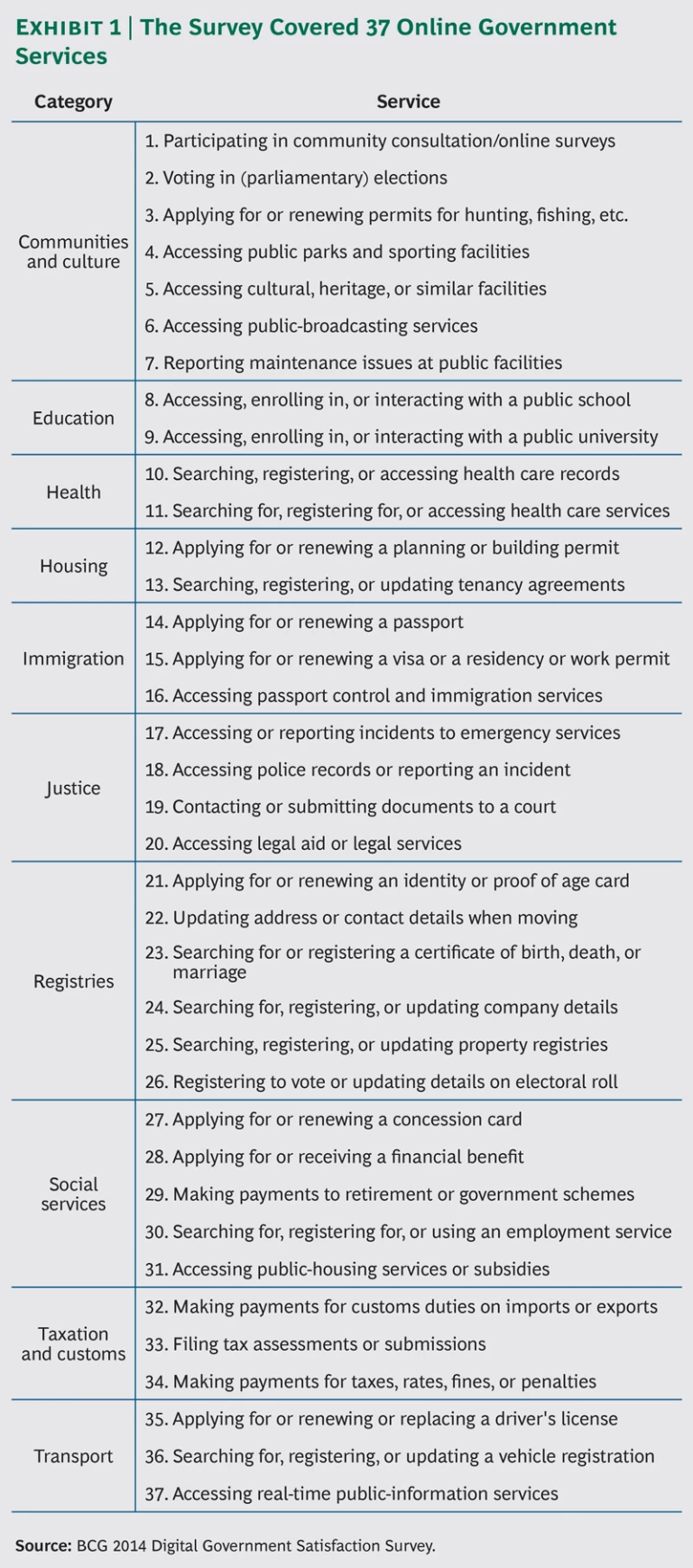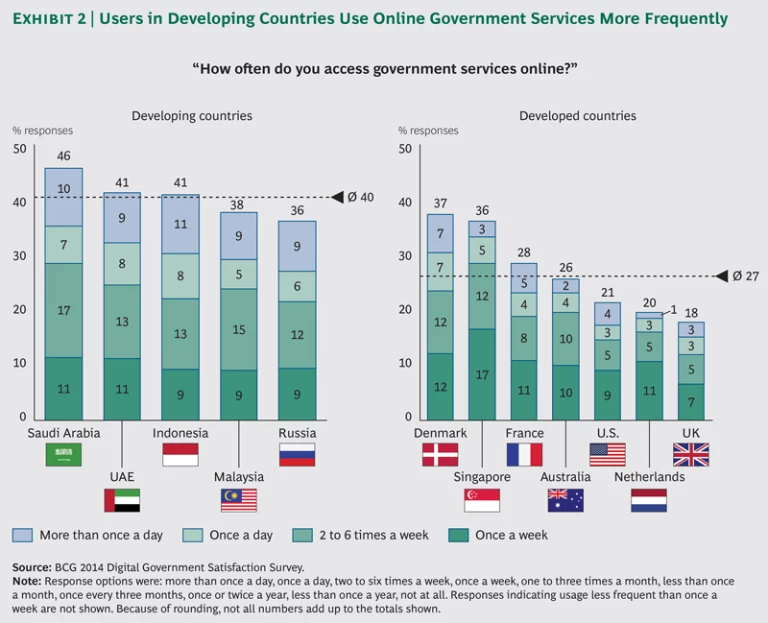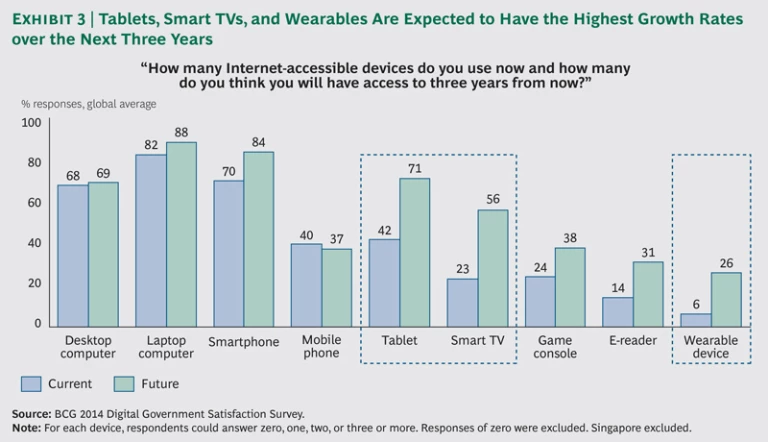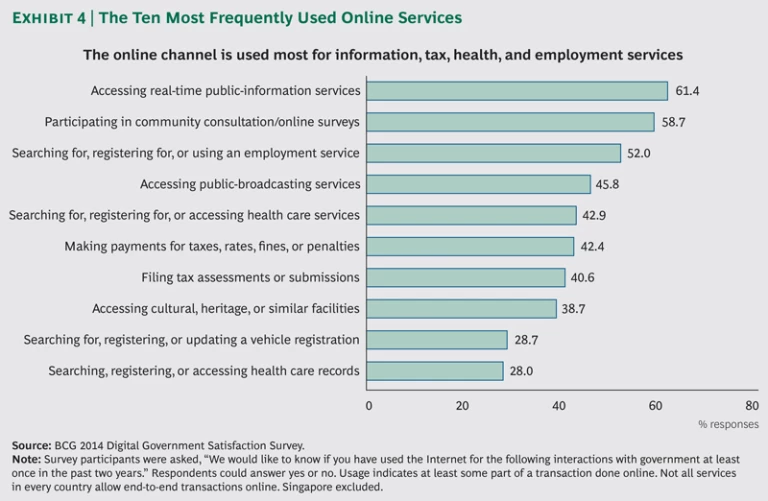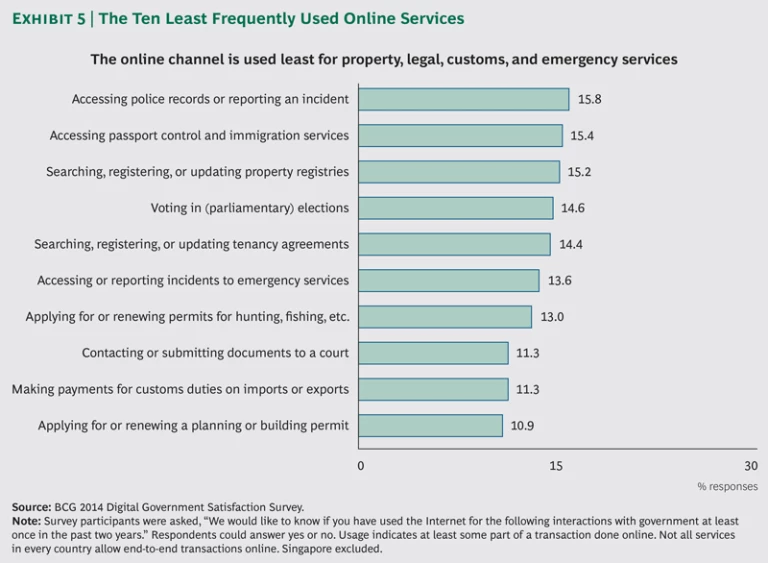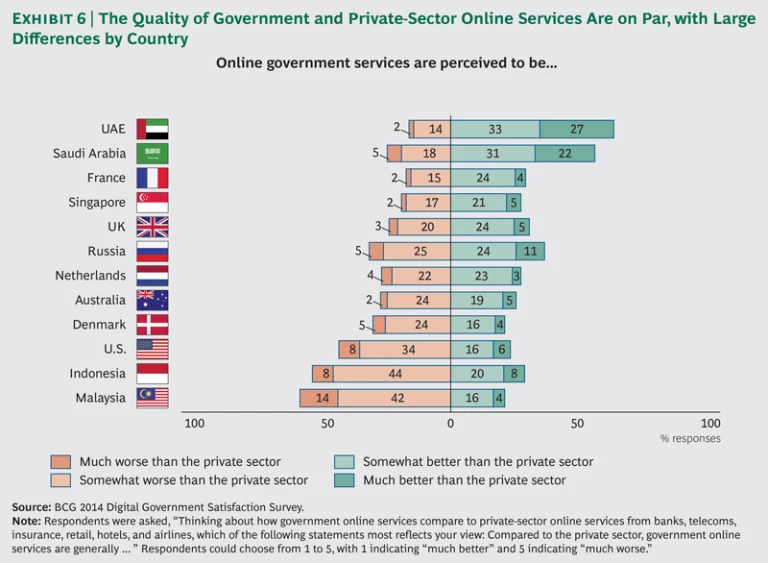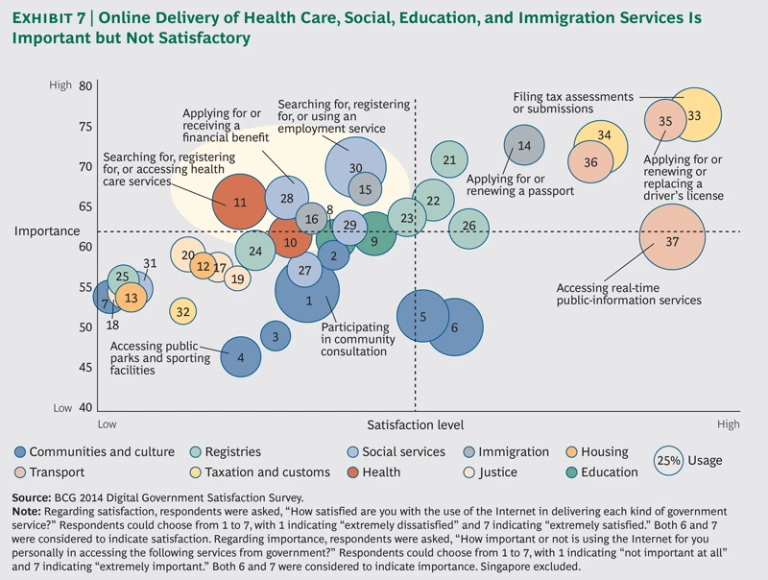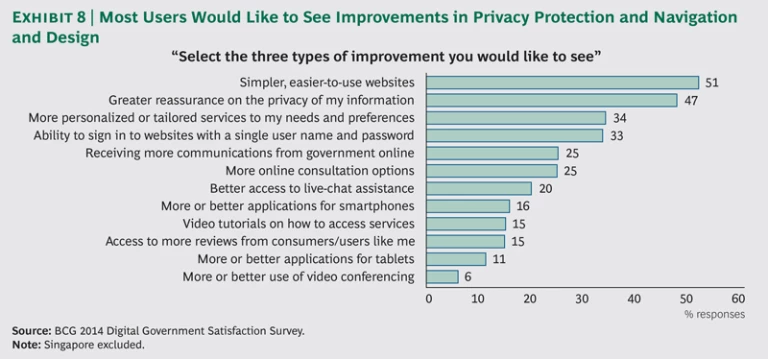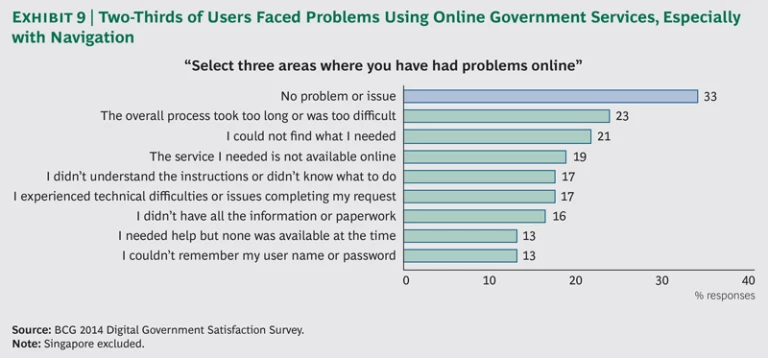Getting better—but still plenty of room for improvement: that’s the current assessment by everyday users of their governments’ efforts to deliver online services. The public sector has made good progress, but most countries are not moving nearly as quickly as users would like. Many governments have made bold commitments, and a few countries have determined to go “digital by default.” Most are moving more modestly, often overwhelmed by complexity and slowed by bureaucratic skepticism over online delivery as well as by a lack of digital skills. Developing countries lead in the rate of online usage, but they mostly trail developed nations in user satisfaction.
Many citizens—accustomed to innovation in such sectors as retailing, media, and financial services—wish their governments would get on with it. Of the services that can be accessed online, many only provide information and forms, while users are looking to get help and transact business. People want to do more. Digital interaction is often faster, easier, and more efficient than going to a service center or talking on the phone, but users become frustrated when the services do not perform as expected. They know what good online service providers offer. They have seen a lot of improvement in recent years, and they want their governments to make even better use of digital’s capabilities.
Many governments are already well on the way to improving digital service delivery, but there is often a gap between rhetoric and reality. There is no shortage of government policies and strategies relating to “digital first,” “e-government,” and “gov2.0,” in addition to digital by default. But governments need more than a strategy. “Going digital” requires leadership at the highest levels, investments in skills and human capital, and cultural and behavioral change. Based on BCG’s work with numerous governments and new research into the usage of, and satisfaction with, government digital services in 12 countries, we see five steps that most governments will want to take:
1. Focus on value. Put the priority on services with the biggest gaps between their importance to constituents and constituents’ satisfaction with digital delivery. In most countries, this will mean services related to health, education, social welfare, and immigration.
2. Adopt service design thinking. Governments should walk in users’ shoes. What does someone encounter when he or she goes to a government service website—plain language or bureaucratic legalese? How easy is it for the individual to navigate to the desired information? How many steps does it take to do what he or she came to do? Governments can make services easy to access and use by, for example, requiring users to register once and establish a digital credential, which can be used in the future to access online services across government.
3. Lead users online, keep users online. Invest in seamless end-to-end capabilities. Most government-service sites need to advance from providing information to enabling users to transact their business in its entirety, without having to resort to printing out forms or visiting service centers.
4. Demonstrate visible senior-leadership commitment. Governments can signal—to both their own officials and the public—the importance and the urgency that they place on their digital initiatives by where they assign responsibility for the effort.
5. Build the capabilities and skills to execute. Governments need to develop or acquire the skills and capabilities that will enable them to develop and deliver digital services.
This report examines the state of government digital services through the lens of Internet users surveyed in Australia, Denmark, France, Indonesia, the Kingdom of Saudi Arabia, Malaysia, the Netherlands, Russia, Singapore, the United Arab Emirates (UAE), the UK, and the U.S. We investigated 37 different government services. (See Exhibit 1.)
Almost 95 percent of the respondents to our survey have used at least one online government service in the last two years. An average of 32 percent use online government services more than once a week. Overall, we found relatively high satisfaction levels, especially with basic interactions. Satisfaction falls away and frustrations rise, however, among more digitally experienced younger users, who have higher expectations for the online experience, and among people who try to engage in more sophisticated tasks and transactions. (See “Defining Satisfaction and Importance.”)
DEFINING SATISFACTION AND IMPORTANCE
In each country we surveyed, we asked users to rate their usage of and satisfaction with the online delivery of 37 different types of service. We also asked them to rank the importance of online delivery of each service—now and in the future. (The exception was Singapore, where the survey instrument was slightly different; for this reason, Singapore is not included in some of this report’s exhibits and the appendix.) For each type of service, users were asked to rate satisfaction and importance on a seven-point scale: 1 = not satisfied/important; 2 = rather unsatisfied/unimportant; 3 = somewhat unsatisfied/unimportant; 4 = neutral; 5 = rather satisfied/important; 6 = somewhat satisfied/important; and 7 = very satisfied/important.
In order to assess firm levels of satisfaction and importance, we counted only the “very satisfied/important” and “somewhat satisfied/important” responses when we compiled the results. Users whose opinions were “soft” (rankings of 3, 4, and 5 on the scale) were all considered as “neutral.”
We also discovered the following:
- The services with which users are least satisfied are sometimes the ones they consider the most important, including those related to health, immigration, welfare, and justice.
- Users in developing countries access more services online and access them more frequently. Users in these countries also place greater importance on online service delivery.
- While there are wide variations among countries, governments generally compare well with the private sector. People like the direction governments are heading in; they want them to do more.
- Governments face changing patterns of usage and demand. The Millennial generation—18 to 34 year olds, who now outnumber baby boomers—have higher expectations than older people. Millennials are the most frequent but least satisfied users of online services.
- Governments need to design services to work across different platforms and devices. More users are accessing services on laptops, smartphones, and tablets. Future usage will trend toward more tablets and Internet-enabled TVs.
We also look at the current state of digital government-service delivery, the areas where user satisfaction falls short, the barriers to wider and better delivery, and what governments can do to encourage more widespread use of digital services.
Despite making good progress, for most governments, the big challenges still lie ahead. The breadth and depth of demand will increase substantially in the next few years—breadth in terms of both numbers of users and the range of services they wish to access online, and depth in terms of how much they want to do, the devices they want to use, and the increasing sophistication of the interactions in which they seek to engage. This combination will raise the bar for every government in both service design and technological know-how. But the potential payback—money saved, efficiencies achieved, and enhanced competiveness with other nations—is enormous. In research undertaken jointly with the Secure Identity Alliance, BCG has estimated the potential efficiency benefits of e-government programs globally at up to $50 billion a year by 2020. It is worth doing something about it.
Digital Services Today
People are doing more online. Almost 80 percent of the respondents to our survey access the Internet more than once daily for personal use. More than 75 percent use three or more devices for online access.
As we observed in our report on digital satisfaction in the U.S., people share a consistent set of priorities and expectations for online interactions. (See Delivering Digital Satisfaction: U.S. Consumers Raise the Ante , BCG Focus, May 2013.) These are the result of people’s real-world experiences, their personal understanding of what technology can do, and what online leaders such as Amazon, Apple, Google, and others have demonstrated can be delivered. For example, online processes are often quicker and more efficient than offline encounters involving long lines, extended call-wait times, and unsatisfactory service. Consumers appreciate the medium’s mobility, interactivity, and ability to make things fun. More and more these days, they also expect the digital experience to be local (recognizing where they are), personal (tailored to their individual needs and preferences), social (shared with their friends)—and always on.
Plenty of Users and Wide-Ranging Demand
People use the Internet to access a wide range of government services. Some access these services a lot. As noted, an average of 32 percent of respondents in the 12 countries surveyed use online government information and transaction services once a week or more. Already, at least half of users in most of the countries surveyed want digital channels to play a greater role in the delivery of key services.
The average user accesses ten different kinds of service. Online channels are used most for transportation information, tax filings and payments, and health and employment services. They are used least for property, legal, customs, and emergency services. While usage patterns are broadly similar across the 12 countries surveyed, there are some significant variations. High percentages of users in Saudi Arabia and the UAE access services related to residency and employment. Both these countries have large populations of foreign workers. Accessing cultural institutions and public-broadcasting services is a popular activity everywhere.
There is high correlation between the number of services used online and the frequency with which they are accessed. Usage tends to be highest in developing countries, many of which do not have legacy IT systems and channels. (See Exhibit 2.) Users in these countries access 50 percent more government services on average than those in developed nations—12 types of services compared with 8. A higher proportion of developing-country respondents (40 percent versus 27 percent) use online government services at least once a week. Developing-country respondents find online delivery of government services more important, and they express greater interest in more digital delivery of these services.
We found little correlation between income levels and service access, with usage fairly evenly spread across the income scale. City dwellers tend to be more active users. Retired and unemployed people are the least frequent users of online government services; students are the most.
Usage is evolving. Millennials are much more likely than older people to access government services online. These people grew up in a digital world, and their ranks are set to swell. In the U.S., for example, adult Millennials will outnumber non-Millennials by 22 million in 2030. Just as many people already use smartphones as use desktop PCs to go online. Governments will increasingly be interacting with more digitally savvy citizens on an expanding variety of devices, especially tablets, smart TVs, and wearables. (See Exhibit 3.)
Some Digital Services Are More Important Than Others
Almost across the board, substantial majorities of users see online services as important, and as we shall see, they are looking for governments to improve the quality of their offerings. On average, 60 percent of users rank online government services as important.
That said, all services are not regarded equally. Many more users view services such as filing tax information, paying taxes, and applying for passports and driver’s licenses as more important than paying customs duties, applying for a building permit, or checking police records. (See Exhibits 4 and 5.) Online housing services and school enrollment are especially important to Indonesian users. Social services are very important in the Netherlands. Users across Europe want the ability to file tax assessments, while this is not relevant in Saudi Arabia and the UAE, where individuals do not pay income tax.
Overall, people in developing countries are heavy users of services that have a significant impact on life and livelihood, such as those related to health care and education. They are embracing the Web for much more than reasons of convenience; they are using it to improve their well-being and earning ability.
Governments in developed countries have done a more complete job of bringing full-service capabilities online, especially in areas related to taxation, transportation (vehicle registration, driver’s licenses), personal and business registration, and cultural and leisure activities. However, the Internet can still play a much bigger role in these countries. A great deal of information is available online, and some countries are moving aggressively to implement transactional capabilities, but in many nations, full digital interaction has yet to be developed.
The State of User Satisfaction
Satisfaction rates are generally high—but they could be much higher. The percentage of users who are satisfied with online government services ranges from 41 percent in Russia and Malaysia to 61 percent in the U.S. Generally, more users in developed countries are satisfied (42 to 61 percent) than in developing nations (41 to 52 percent).
Users recognize that governments are making an effort. Nearly four in five users believe that online government services have improved over time. Developing-country governments get particularly high marks—almost 85 percent of users say service delivery is improving, compared with 72 percent who see improvement in developed nations, although developing countries are probably starting from a lower base.
Governments compare well—in some cases, better than might be expected—with the private sector. Overall, the quality of online public- and private-sector services is roughly equal, although there are wide variations across countries. While the role of the public and private sector is different in each country, we take the results to indicate a strong vote of confidence in governments’ efforts so far. (See Exhibit 6.)
In just about every country, there are a few key services whose importance is regarded as high but satisfaction with their delivery is low. Governments can make a quick impact by concentrating their efforts on improving and expanding delivery in these areas, which often include services such as employment, health care, and social welfare that are especially important to users’ lives and livelihoods. (See Exhibit 7.)
The UAE, for example, has introduced an online transactional platform that allows both nationals and residents to more efficiently manage the administration of their health care. Online capabilities include issuing and renewing health cards, identifying health care providers, and scheduling appointments.
The online platform also provides services to health care providers, among them a database of citizens’ immunization records, an infectious-disease reporting system, and a service to facilitate the approval of medical advertisements.
Saudi Arabia achieves above-average satisfaction ratings for immigration-related services, many of which include end-to-end capabilities. Almost two-thirds of users are satisfied with the process for applying for or renewing visas and residency and work permits. Similarly, 60 percent are satisfied with their access to passport control and immigration services.
Indonesia has introduced an enrollment portal for primary and secondary schools that provides fairer, more equal, and more transparent access to the country’s schools, easing the application process and reducing the potential for impropriety or corruption. Students can complete the registration process online and track the selection process through final approval.
The portal has been made the default process so that in most cases, students who choose to apply manually still have their data loaded onto the website for processing.
The Bar Will Be Raised
Governments will face challenges similar to those of businesses that need to serve customers seamlessly through multiple online (and offline) channels, platforms, and devices. They will need to “set out their store” across the full range of online connectivity.
The most immediate, and perhaps the most important, challenge is coming to terms with the transformative effects of mobile technology (see “The Growing Impact of Mobile”), but the impact of technological advancement extends well beyond individual interactions.
The Internet, social media, and mobile devices greatly amplify users’ opinions and their effect. Governments can expect that as more younger users access services, positive experiences will prompt them to let their universe of friends—real and virtual—know that there is a better way of engaging with the public sector. A bad—or even just a disappointing—experience, on the other hand, can turn any user into a vocal critic, who can spread the negative word through social media, reviews, and blogs. And that criticism can go viral.
Governments have their work cut out for them. Facilitating license or permit renewals and providing public-transport information are important services, but they are relatively easy to provide. Helping people access health care, providing education and training, and assisting in a job search are much more complicated tasks. Everyone’s need is different.
Overcoming Barriers to Digital Use
Users value digital delivery of government services. Some 60 percent say it is important. Almost 55 percent would like more services to be delivered online in the future. These numbers rise in areas that are viewed as especially significant, such as accessing health care (64 percent say it is important; 59 percent want future delivery) or using an employment service (69 percent say it is important; 62 percent want future delivery).
There are barriers to increasing online use, however. As we have observed elsewhere, many of these have to do with broader issues such as telecom infrastructure, broadband penetration, the cost of access, and education, but a good number of impediments are service-specific and within the purview of governments to address. (See Greasing the Wheels of the Internet Economy , BCG report, January 2014.) Users are quite clear on where they would like to see improvement: ease of use and the protection of personal data and privacy online. (See Exhibit 8.)
Two-thirds of the respondents to our survey experienced problems while using government online services. More than 60 percent cited issues related to website navigation and design. Almost a third encountered problems with help and support. (See Exhibit 9.)
Ease of Use Is Not Always So Easy
Providing easy access and the ability to find and compare options are among the top drivers of digital satisfaction. Users want easy-to-navigate websites, intuitive user interfaces, one-click transactions, and easily accessible online support and service, and they have come to expect such interactions from any online entity with which they interact frequently.
These are critical issues for governments to address. However complex the actual delivery mechanism, the digital experience should be simple, seamless, and secure from the user’s point of view. Governments should not underestimate the impact of basic improvements in the user experience, such as providing the ability to access all services with a single digital credential, regardless of department or agency, or a website that gets users where they want to go.
Such experiences are not necessarily difficult to provide, but taking the kind of unified, coordinated approach to design and delivery issues that they require does not come naturally to government bureaucracies. Doing so quickly, especially when problems emerge that straddle departmental dividing lines, is a further challenge. In some cases, providing the capability for end-to-end digital transactions may require a policy change—and the political sponsorship to implement it. Concerns over security, risk, legal issues, and compliance can all conspire to slow things down.
There are good models to emulate. French users can access some 30 services with a single user name and password through the website mon.service-public.fr. The Australian government last year launched its myGov portal, which offers simplified registration and authentication processes, quick access to a range of services with one user name and password, and easy linking to existing accounts and connections to new services. Some 2 million Australians now have a myGov account. Singapore’s SingPass program provides a single online authentication system through which users can access 270 different services from 58 government agencies using one identifier and password, starting from one point of departure. SingPass has a more than 90 percent utilization rate, with better than 80 percent satisfaction among users. It saves time, provides a high degree of convenience, and addresses a specific consumer need—simplifying interaction with essential government agencies. (See “Evolving Approaches to Integrated National Portals.”)
EVOLVING APPROACHES TO INTEGRATED NATIONAL PORTALS
Many governments have instituted online portals to their services. All seek to connect users with information and services in an efficient manner. Integrated portals will continue to evolve, but governments considering enhancing their own online—and mobile—offerings can learn a lot from these leaders.
Once users log on to Australia’s www.my.gov.au, they can seamlessly access content across six different government health and welfare services. The Department of Human Services sought user input in the design process to ensure that myGov would be intuitive and logical for users as well as simple (no more than four navigation steps required), fast (most end-to-end transactions take under five minutes), and responsive. Another portal, australia.gov.au, connects citizens to the information and services of some 900 government websites and state and territory resources. It offers extensive information on the government of Australia and its activities.
Through South Korea’s integrated portal, www.korea.go.kr, citizens can find links to almost all government services and browse websites according to topic or by agency or department at both the national and local-government level. They can also create a customized experience by inputting their age and gender and the services of interest. Downloadable content (including for mobile devices) includes information relating to e-learning and employment. Mobile integration is strong. Many of the linked e-government services have complementary apps for devices running both Android and iOS. QR codes (a form of barcode) are consistently available across websites, allowing a user, for example, to link to a downloadable app relevant to the service in question.
Singapore’s government portal categorizes content by user group: citizens and residents, nonresidents, and businesses. The portal for citizens and residents, www.ecitizen.gov.sg, is a true integrated portal with strong search capabilities across a wide range of interactive transactional services. Online payment is emphasized; the capability is offered for a wide range of services. Transactional services other than payment are more limited, although they do extend to services such as applying for passports and identification cards and registering for overseas travel.
The U.S. general-service website, www.usa.gov, is well regarded. (The UN’s E-Government Survey 2012 found it to be “perhaps the best example of a highly integrated portal.”) The portal arranges content according to user needs rather than government structures (for example, it provides links to “consumer protection” rather than to federal and state law-enforcement and regulatory functions). It starts from a general level of information for those who do not know exactly what they’re looking for and adds prompts to assist user navigation. Content is easily searchable if a user is unable to find what he or she needs by browsing. The site provides clear ways to communicate with the government for technical assistance and on policy issues. While the portal does not host transactional services, it contains links to state and department websites, which do have transactional capabilities.
The big challenge that these and other governments face is continuing to improve the navigation experience while at the same time bringing online an expanding range of transactional activities.
The Growing Impact of Mobile
The rapid rise of mobile usage raises both the complexity and the stakes for governments and their digital strategies.
Numerous factors are converging to give mobile the capabilities, scale, and reach achieved by few other technological advances. These include devices with computing power and memory that come close to rivaling desktop PCs, increasingly ubiquitous network coverage, smartphone and tablet functionality akin to that of a Swiss Army knife, geolocation capabilities, and vibrant application-development ecosystems with large and growing user bases. Combine these factors with two demographic realities—the maturation of the Millennials, whose primary online experience is mobile, and the fact that the vast majority of the world’s population lives in developing markets, where the Internet experience is mostly mobile—and it’s easy to see that as the next billion consumers come online, it will be through an Internet-enabled smartphone or feature phone.
Consumers will increasingly want to access government services like they do any others. Just like companies in the private sector, governments need to expand their outreach models beyond PCs and websites. Our survey showed that people are looking to do more on smartphones and tablets. For the last two years, French taxpayers have been able to file their taxes using their smartphones, and 80,000 did so in 2012. More than nine out of ten users express satisfaction with France’s online tax-paying service.
Even as they determine how to bring more services online and offer greater interactive capabilities, governments also need to think in terms of designing apps, services, and content to work across multiple devices—a PC at work, a laptop on the road, a tablet at home, a smartphone on the move anywhere. The demand for digital design expertise and technological capability, whether developed in-house or contracted for outside, will only continue to increase in the coming years.
Privacy: The Third Rail?
Privacy and personal-data protection are key issues for all users but especially for those accessing justice, health care, and community services. This issue goes to the heart of all manner of online activities. For governments, because of their role and the unfortunate history of some, it is perhaps the most fundamental issue that they need to address.
We have written elsewhere that high-profile data breaches and missteps involving personal data have led to a decline in trust in how governments (as well as other organizations) protect and use information, including personal data. (See “Rethinking Personal Data: Strengthening Trust,” BCG article, May 2012.) Concern about the use of personal information is present everywhere, although the level of apprehension, and of trust, varies widely by region and country. There are multiple aspects to this issue but the most basic is protection and security: How can personal data be protected and secured against intentional and unintentional security breaches and misuse? The U.S. has several times investigated options for online voting, especially for its armed forces stationed abroad, but has not proceeded because of concerns over the security of the process. The Australian Taxation Office plans to use voice-matching technology to identify individuals phoning in, which, in addition to making voice communication more secure, saves up to 45 seconds in both user and staff time per call. Unless users of government services can be assured that strong and appropriate protections are in place, they will be hesitant to hand over the data necessary for service access and delivery online.
We have also argued that to earn the right to use data, companies must do two things—and the same applies to governments. (See “ Why Trust Is More Important Than Ever ,” BCG video, August 2013.) First, they must establish clear policies about data use that spell out how and when they will request permission to use data, the steps they will take to oversee its use, and the protocols and metrics that will deter and detect violations. Second, they must be transparent with users. They should be up-front about their policies, describing them in plain, simple, nontechnical language, as well as about the safeguards designed to uncover and report any potential problems.
Turning Rhetoric into Reality: What Governments Can Do
While countries are spread all along the adoption curve, it’s clear from what users say about the importance of, and their satisfaction with, the digital delivery of government services—as well as their expectations for the future—that just about every government can do more to provide a better, more effective digital experience.
Here is a five-step roadmap that any government can follow to improve digital service delivery.
Focus on Value
Given limited resources, governments should concentrate their efforts on addressing the biggest gaps—the services that are most important to constituents and the ones with which they are currently least satisfied. In most countries, this will mean e-health, online services for social security and welfare, online education services and e-learning, and digital self-service for visa and immigration services.
It is good to set bold targets and ambitious timetables, as countries such as the UK, Denmark, Australia, and Qatar have done. Such goals—so long as they are backed up with action—will focus attention on delivery and send a strong message to both government officials and citizens that change is on the way.
Adopt Service Design Thinking
This may be the most important—and for some, the most difficult—step to take, since good service design does not always come easily to the public sector. Designing a seamless and fulfilling end-user experience is not an accident but is rather the result of adopting tools, practices, and techniques from the growing discipline of service design thinking.
Governments need to put themselves in the shoes of the users of their services. What do people encounter when they go to a government service website on a PC or a mobile device? How easy is it for them to navigate to the information they seek? How much “clutter” do they encounter en route? How many steps does it take to do what they came to do? The answer, of course, is that far too often, the user experience is far too difficult.
Analysis of existing data on user interactions can yield surprising opportunities for simple changes that make it easier for people to find what they need. For example, by knowing how users got to where they ended up, designers can make it easier for people to find what they are looking for. If content on government websites is never accessed, get rid of it! Listening to users express their frustrations, and simplifying processes wherever possible, will go a long way toward addressing their concerns.
While IT, legal, and security departments all have roles to play, don’t let them drive their particular concerns over the user experience. The conservative and risk-averse nature of government is not an ally in the digital world.
Lead Users Online, Keep Users Online
The agencies that are succeeding in migrating customers online are doing so largely by providing seamless end-to-end capabilities and closing down alternatives by phasing out over-the-counter or over-the-phone services for most users over time.
Too many agencies allow a user to start a process online but require completion through an offline channel, such as printing and mailing a form. Or they require offline proof of identity in order to access services online. These steps add cost, frustrate users, and undermine confidence in a government’s commitment to online service delivery. Do online retailers ask customers to go to a store to establish a digital account? Do they require mailing a check to complete a purchase?
The best online experiences are end to end: they start with the one-time establishment of an online identity or account (as with online retailers) and then enable the user to complete his or her business, including identity verification and the submission of any necessary documents or information, through a variety of digital methods. The user never has to leave his or her computer—or smartphone or tablet.
In France, for example, tax assessments are pre-filled with available data by the government. Some 2 million families choose not to receive any paperwork associated with their tax filing, preferring a completely online experience, and 90 percent of company taxes are paid via online services.
A commitment to “no wrong door” policies does not mean having to offer every service through every channel. This is costly and unsustainable in the long run. Governments can guide users online as they phase out offline channels over time.
Demonstrate Senior Leadership and Commitment
Digital services need a senior-level champion who will make the commitment to moving government services online a top-three priority. Governments signal the importance and the urgency that they place on their digital initiatives by where they place responsibility for the effort.
The ruler of the UAE, Sheikh Mohammed bin Rashid Al Maktoum, declared earlier this year, “I want every citizen to perform government transactions via mobile phone.” The UK’s digital strategy is overseen by a cabinet-level minister, Francis Maude. Leaders at this level are able not only to set clear strategy, agendas, and policy with aggressive targets and timelines but also to help ensure the essential cooperation and coordination among departments and agencies.
Equally important, if governments want citizens to change their behavior, they need to change their own. They can hardly expect people to go online and stay online if agencies are still mailing out paper letters and statements. Governments should begin the transition to electronic communications as soon as possible.
Build the Capabilities and Skills to Execute
Governments, like private-sector companies, need to develop or acquire digital capabilities. This is especially difficult in the public sector because digital talent is not naturally attracted to public service. What skills a government does have are often fragmented across departments and agencies.
Delivering digital services is likely to require a strong central team to drive the strategy. The team may benefit from having a senior leader from outside the public sector. It may be necessary (and more cost effective) to contract with outside service providers.
The UK has had some success by starting the development of its digital strategy with the strong engagement of leaders in the sector. The government created a separate unit to work on the project—Government Digital Service—that is distinct from other ministries and agencies and able to develop its own practices and culture. An advisory board of external experts was brought together to support the new unit. The unit itself has worked to capture the innovative and entrepreneurial culture that is a hallmark of successful digital companies, to the point that, according to the Wall Street Journal, it is now described in some of the UK’s leading technology forums as “the UK’s most innovative start-up.” (See “UK Goes Digital by Default.”)
UK GOES DIGITAL BY DEFAULT
The UK government launched a comprehensive digital strategy in November 2012, combining 11 “central principles” and 14 “concrete actions” (later expanded to 16) to build a framework for reengineering government and redesigning digital services. The program is anchored at the cabinet level.
The strategy is clear-cut: transitioning the UK to a government that is digital by default, which is defined as “digital services that are so straightforward and convenient that all those who can use them will choose to do so whilst those who can’t are not excluded.” The plan is expected to result in savings of £1.7 billion to £1.8 billion a year.
The program started with the publication of the digital strategy, followed by the targeting of 25 “exemplar” services for end-to-end digital reengineering. These included services related to registration, immigration, justice, and social services, among other areas. The process comprises four design phases for each service: discovery (learn), alpha (prototype), beta (test), and live (achieve outcomes).
The following are some key attributes of the UK’s strategy:
- Senior leadership and investment are committed for an extended period of time.
- There is a concrete vision with clear and aggressive goals, including a target of 80 percent digital service. The strategy commits the government to specific actions. Progress is reported quarterly. The first wave of 25 exemplar services are being moved online, and all large new or redesigned digital transactional services that go live after April 2014 will be digital by default.
- A specialized Government Digital Service team has the mandate to further the digital-by-default agenda and maintain the central website, gov.UK. A core central team separate from traditional government structures and constraints focuses on driving the overall vision forward.
The websites of UK government departments have been consolidated into one gov.UK point of access. The next phase is the digital transformation of the exemplar services—1 service has already gone live, 15 are in the beta phase, and another 6 are in the alpha phase. Ministers have started to explore how to open up government transactions so they can be delivered easily by commercial organizations and charities. The government is making sure that no one gets left behind as it goes digital, helping departments think about what they can do to get service users online.
Digital transformation is a journey that will take planning, time, and continuing adjustment. Governments should keep two issues front of mind. One is the need for strong policies and procedures to protect user privacy and personal data. The second is the need to assist those without ready digital access or the ability to use digital tools. There will always be a significant percentage of people who are disabled, disadvantaged, or regionally isolated. Face-to-face and telephone channels will continue to play a role in providing support to these citizens.
Governments can give themselves a pat on the back. They have brought a large number of services online, and they have done a good job moving to more digital delivery. They are recognized for their efforts by users. But they cannot rest on their laurels. People are impatient. Having seen the potential, they are eager for more. As users gain sophistication—and as sophisticated users grow in number—expectations will only continue to rise.
